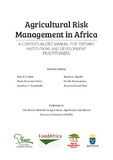| dc.description.abstract | Since 2012, the African Network for Agriculture, Agroforestry and Natural Resources Education
(ANAFE) has been supporting initiatives to unravel the complex issues surrounding risk management
in agriculture and natural resources management. At various workshops and other forums, stakeholders
of ANAFE (educators, farmers, students and agribusiness entrepreneurs) have expressed the need to
develop adequate capacity on risk management. A recent survey on risk management education revealed
that there is very little teaching of agricultural risk management. Worse, it was established that current
educators do not have skills in this area and that relevant learning resources were not available. ANAFE
was tasked to resolve this situation by providing guidance on curricula, capacity building for educators
and the development of learning resources.
As a way of strengthening the capacity of lecturers in developing learning materials, ANAFE through
its programme of Strengthening Africa’s Strategic Agricultural Capacity for Impact on Development
(SASACID) has trained and supported about 40 lecturers to collaboratively develop learning materials
in Agricultural Risks Management.
This book is a compilation of chapters on risks management collaboratively developed by African
experts on this subject, including lecturers, scientists and development/private sector people from
22 training, research and development institutions and from 12 countries (Cote d’Ivoire, Mali, Niger,
Nigeria, Cameroon, Ghana, Botswana, Zambia, Zimbabwe, Mauritius, Kenya and Ethiopia). The
authors, met in Abidjan for training on collaborative writing during which they agreed on the main
areas of focus, sections, teams and the structure of the chapters. A follow-up write shop held in Nairobi
allowed the authors, together with some who were nominated, to jointly develop the chapters. The main
introduction to the book that was initiated in Abidjan, during the first workshop under the leadership
of some of the authors, was also collaboratively developed and finalized with the input of all the authors.
This book is a pioneer initiative in Africa and which, I am sure, will help lecturers in refining their own
learning and teaching resources. It might not address all the issues in | en_US |


